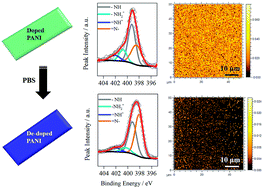Elucidating the deprotonation of polyaniline films by X-ray photoelectron spectroscopy†
Abstract
Spin-coated polyaniline (PANI) thin films can be made conductive following treatment with a dopant (reducing or oxidising agent). However, de-doping results in loss of electrical properties. We chemically doped PANI films using p-toluene sulfonic acid (pTSA) and camphor sulfonic acid (CSA) and examined their ability to retain these dopants and their conductive properties in physiological media. Changes in the protonation level of these films were assessed by N 1s core line spectra in X-ray photoelectron spectroscopy (XPS). PANI films were found to de-dope with a decrease in the ratio of N 1s photoelectron signal corresponding to positively charged nitrogen (i.e. –NH2+, ![[double bond, length as m-dash]](https://www.rsc.org/images/entities/char_e001.gif) NH+) to the total N 1s signal. De-doping of PANI films was confirmed by depletion of the dopant fragment (–SO3−) as determined from both XPS and atomic distribution in Time-of-Flight Secondary Ion Mass Spectrometry (ToF-SIMS) images. XPS has been successfully used as a tool to elucidate the deprotonation of PANI films and the loss of the dopant from the bulk.
NH+) to the total N 1s signal. De-doping of PANI films was confirmed by depletion of the dopant fragment (–SO3−) as determined from both XPS and atomic distribution in Time-of-Flight Secondary Ion Mass Spectrometry (ToF-SIMS) images. XPS has been successfully used as a tool to elucidate the deprotonation of PANI films and the loss of the dopant from the bulk.

- This article is part of the themed collections: Highlighting materials research in the UK for optical, magnetic and electronic devices and Bioelectronics

 Please wait while we load your content...
Please wait while we load your content...